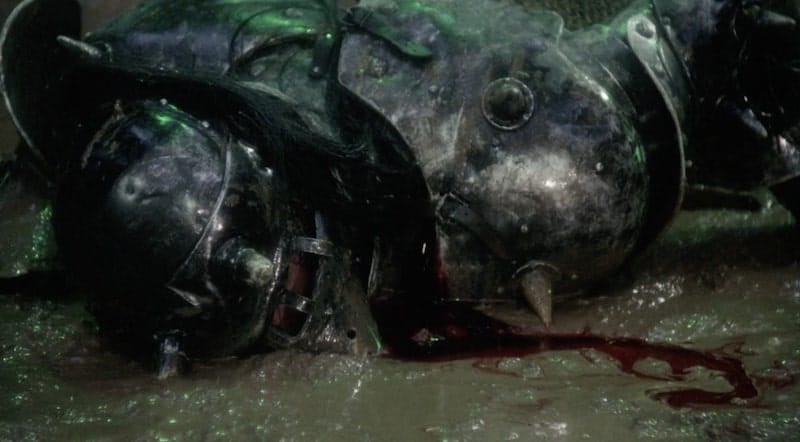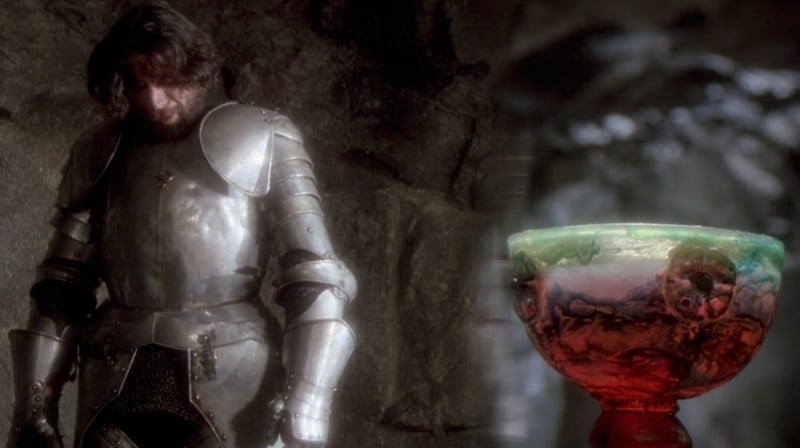When Excalibur (1981) begins, Uther Pendragon (Gabriel Byrne) lies dying in the mud. The magician Merlin warned him that granting his wish would have consequences; that one night with Igrayne, the wife of his newly-won ally, would come at a price. As promised, Merlin arrives to collect Igrayne and Uther’s child: an infant of infinite promise, a future king who will succeed where his petulant father failed. With Igrayne’s shrieks ringing in his ears, Uther follows Merlin into the woods, begging for his son and blind to the ambush lying in wait.
Torn off his horse, Uther lands face-first in a polluted creek; the legendary preface of Arthurian legend dragged quite literally into the mud. The imposing spikes of Uther’s armor lock him firmly into the earth. Blood pools from the crease in his shoulder plate, flowing freely like a crimson tributary into the muck. It is a beautiful and brutal image: a deep red plume streaming out from a once-glimmering suit of armor. The whole scene is bathed in an emerald glow, an otherworldly colored gel that casts this upsetting moment firmly into the realm of myth.

This contrast — of fantasy and ferocity — is the beating heart of Excalibur. It’s a tension that not only defines the film’s production design but the narrative journey of Arthur himself: a feature-length give and take between a gilded legendary past and the harsh realities of the very history it mythologizes.
In many ways, Excalibur is the favorite child of sword and sorcery movies, a genre that lived, and ultimately died, in the thrall of its own spectacle. These films envision medieval legend, myth, and heroes through a gold-flecked prism. From Dragonslayer (1981) to Ladyhawke (1985), the genre boasts living prog-rock album covers less concerned with historical accuracy than the look and feel of fantasy itself. Excalibur was not the first of its kind. But it is, at least to me, one of the genre’s essential and most influential texts. And reckoning Excalibur’s central thematic tension — this stylistic and narrative cacophony of grit and glamor — is key to understanding what makes the film so magical.
One of the expressions of this tension is in the film’s music. At times, Trevor Jones’ original score indulges in the expected medieval pan flutes, hurdy-gurdies, and monkish drones. At others, it is knowingly Wagnerian, unsubtle, grandiose, and, in a word, epic. Indeed, many of the film’s most memorable musical moments are outright samples of Wagner’s work. The title credits announce themselves with Siegfried’s explosive dirge from Die Götterdämmerung, which bookends the film as the dying Arthur is shepherded to Avalon. The prelude to Parsifal appropriately accompanies the conclusion of Percival’s (Paul Geoffrey) quest for the Holy Grail: a transcendent sequence that uses Wagner’s ethereal strings to underscore Percival’s political epiphany that the land and its king are one. Another prelude, from Tristan und Isolde, fittingly serves as the leitmotif for a doomed tryst: the love affair between Guenevere and Arthur’s most trusted knight, Lancelot.

And yet, for all its sound and fury, Excalibur’s soundtrack falls silent during scenes of violence. Carl Orff’s Carmina Burana blasts as Arthur and his knights ride through a blossoming apple orchard to their climactic face-off with the incestuous abomination Mordred. But the soundscape of the fight itself is far more honest about the barefaced realities of battle. Instead of triumphant horns and exalting choirs, we hear the rattle of cumbersome armor, the anguished cries of wounded soldiers, and the constant clanging of metal weaponry. In these moments of genuine brutality, from the storming of Leondegrance’s castle to Lancelot’s honor-bound duel with Gawain, the score falls back, and the horror of medieval conflict comes into clear and distressing focus: legends are, as Uther’s death reminds us, built on rivers of blood.
Excalibur stretches across a lifetime, from Arthur’s adolescence to his final moments as an old man. And while it is initially jarring to see 35-year old Nigel Terry play a teenager, by keeping the actors consistent as the characters age, the film can create a startling visual contrast between eager, idealistic youths and their calloused older selves. Arthur’s bright eyes dull as the weight of his legendary purpose ravages his body. Lancelot’s festering guilt twists his cherubic curls into a madman’s mane. And, perhaps most jarringly, Perceval’s bright, clear face grows gaunt and world-weary after fruitless decades of search for a fabled relic that may not exist.
This visual shift playing out before our eyes on the countenance of our heroes’ faces extends to the film’s color palette. The lush, earthy hues of Arthur’s youth are marked with verdancy and promise. The moss entombing Excalibur’s hilt seems almost iridescent, as though it too were benefiting from the uncanny emerald that endlessly glimmers in the mythical blade. Likewise, the formation of Camelot and the fabled round table is vibrant, like a living stained glass window. Everything (and I do mean everything) glitters an almost dream-like effervescence that dances in suits of armor, cups of wine, and bridal veils.
Then Arthur’s reign begins to rot. The film’s Eden-like forests become dark and oppressive, and slowly, the color drains from Arthur’s court. In the final frame of Camelot’s prosperity, Arthur lies unconscious in a chapel, bathed in magenta, steam rising where the mystical bolt of lightning struck his chest. We fade to black, and when we return, the world is saturated, stricken too, it would seem, by the sickness that now grips the land.
The first act’s saturation now appears solely in the sorceress Morgana’s (Helen Mirren) domain, who wields visual splendor like a venomous serpent hoping to hypnotize her prey. Here, color takes on a corrupted aspect, from Percival’s feverish visions of the false Grail to Mordred’s unsettling, statue-like suit of golden armor. It is only when the day is won that warmth returns in the visage of an enormous, blood-red setting sun: a symbol of the end of Arthur’s rule and the coming of yet another cycle of generation and decay.
It is difficult not to get lost in Excalibur’s details, bedazzled, as it were, by its overwhelming sense of visual surety. But after one has recovered, it is rewarding to view the film’s undeniable style for what it is: substance. Excalibur literally tells the story of a legend. But it is equally preoccupied with the shape and purpose of legend itself. The film is genuinely enamored with the idealism and spectacle of myth, with hyper-reflective suits of armor, mystical light sources, and loads (and loads) of glitter. But Excalibur also reminds us that the rise and fall of kings, however vaulted, has its nasty bits. And that there is a brutal beauty in occasionally dragging the mythical past, like Uther off his horse, down into the muck.



0 comments:
Post a Comment